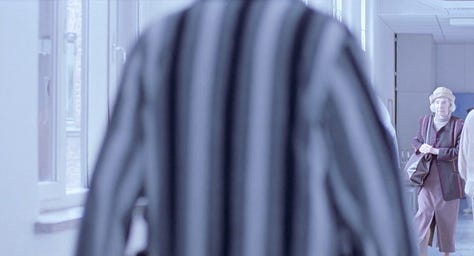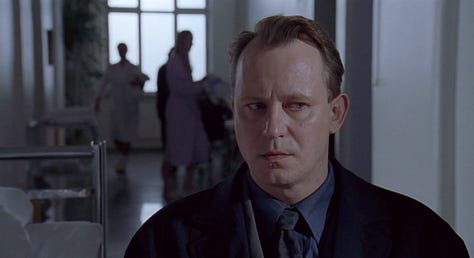Two Techniques, One Effect: INSOMNIA
Both the original 1997 Norwegian film and the 2002 American remake of this psychological thriller follow a detective as guilt and insomnia cause him to unravel. Both films use sometimes-unusual editing and disjointed sound design to give the audience the feeling of losing grip on reality.
Let’s look at how two scenes in 1997’s Insomnia use different techniques to achieve the same — destabilising — effect: first with the editing flow, then with a oner.
It’s crucial the edited scene comes first; we’ll talk about why at the end.


The Edit
When Jonas Engström (Stellan Skarsgård) goes to visit his injured colleague Eilert, Jonas sees his partner Erik (Sverre Anker Ousdal) in the hospital hall.
This is especially strange because Jonas accidentally shot Erik to death (or so far as we know, to death) a day earlier, and is currently trying to cover up his lie that a fugitive killed Erik in the fog.
The scene plays with the ‘rule of three’ and our knowledge of film grammar.
First, it seems the patient in beige bathrobe will ‘wipe’ Erik, only to cut back to Jonas watching, then back to Erik with the beige patient passing.
Then, it seems the striped shirted patient will ‘wipe’ Erik; as he covers most of the frame, the scene cuts back to Jonas again.
When it cuts back the striped shirt is still covering / passing Erik . . .






The third time we cut to where Jonas is looking, we see it is not Erik who emerges, but some other patient who looks quite a bit like him.
Showing ‘Erik’ so many times with the cuts to Jonas seems to confirm what he’s seeing not once but twice before making the reveal, driving tension and undermining our expectations before finally confirming them in a hypnotic rhythmic sequence.
It’s all the more disconcerting because there are no shadows or tricks of the light — it all happens in the same bright, omnipresent light which is distorting Jonas’s sleep.
The Oner
This scene comes near the end of the film, after Jonas has solved the mystery of who killed Tanja.
Next week we’ll look at the practicalities of shooting this oner; but for now: the effect.
As Jonas stares off-screen in shock, the camera swings around so we can see over his shoulder: a couch on which the dead girl Tanja lies staring back at him.
The audio mostly drops out before reemerging with a muffled knock (0:11), which origin is unseen until the camera moves to show Eilert at the window.
From here the camera goes mostly in sweeping, circular motions, even as the shot size changes from closeup to wide.
Other cops entering and walking motivate the camera movement until it comes back around to Jonas again, then past his face in an echoing move to show us the now empty couch.
The lack of reaction from Eilert and the other cops tell us Tanja was all in Jonas’s head; he blankly shoves some evidence into Eilert’s arms before leaving, the camera remaining behind in the room.
Takeaways
It’s important the edited scene happens first because it feels more ‘detached’ — it’s easier for us as an audience to say “this is Jonas imagining things.”
The second scene happening in a oner is more ‘objective’ — we implicitly feel the camera must be showing us things as they really are.
The first time, we expect the reveal multiple times before it finally happens. The second time, not only have we spent more time in Jonas’s mental spiral, we also have the camera making us expect to see someone on the couch, alive or dead. As a result, we’re perhaps as confused as Jonas when the couch is empty.
The choice of editing and oner work as setup and payoff to a sick cosmic joke.




